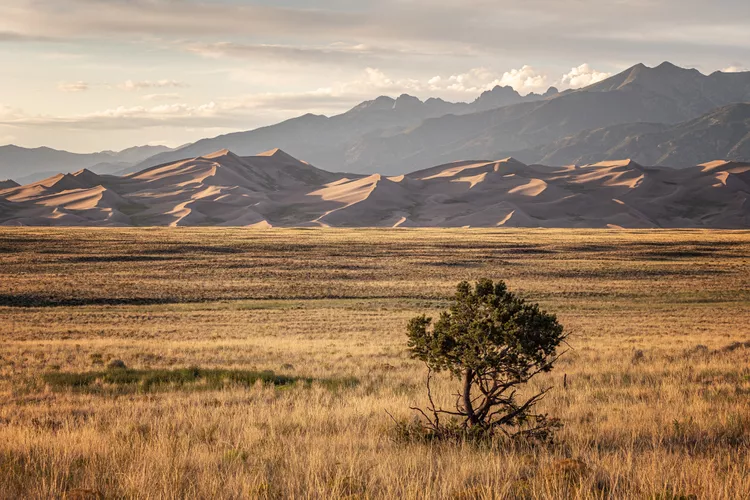Summary
Great Sand Dunes National Park and Preserve is located where the wide-open and dry expanse of the San Luis Valley meets the towering Sangre de Cristo Mountains. At first glance, this Colorado national park seems an unusual place for North America’s tallest sand dunes. However, the unique geography plays a crucial role in forming and maintaining these towering dunes. Geologists explain that winds blowing across the San Luis Valley became trapped in the curve of the Sangre de Cristo Mountains, resulting in a dynamic sediment movement that shaped the landscape we see today.
While the famous sand dunes are the park’s highlight, they are part of a larger, diverse ecosystem that includes grasslands, forests, wetlands, tundra, and alpine lakes. Therefore, exploring this enchanting national park provides visitors with a variety of experiences to enjoy.
Things to Do at Great Sand Dunes National Park
The dunes are undeniably the main attraction, so make sure to start your visit there. Climb the sandy peaks, rent a sandboard or sled, and glide back down. If you’re on the dunes at sunset, take a moment to witness the shadows lengthen and watch as the colors change from sandy gold to a brilliant orangish-coral. The striking “on-fire” dunes against the backdrop of the Sangre de Cristo mountains create breathtaking photography opportunities. Notable dunes to explore include Hidden Dune and Star Dune, both standing at an impressive 741 feet high, recognizing them as the two tallest dunes in North America.
In addition to the dunes, there are forested hiking trails along the edges, such as the shaded Montville Nature Trail and the historic Mosca Pass Trail, once used by Native Americans and early settlers. Late September and early October are particularly beautiful as well, as this time of year brings vibrant golden hues to the aspen trees lining Medano Pass.
Moreover, those visiting during spring and early summer should not miss Medano Creek, a seasonal stream that flows predominantly from May to June. This is a fantastic spot for families to play in the shallow waters. Visitors can also experience the unique phenomenon known as the “surge flow,” as waves ripple across the sand, making for exciting visual displays.
In addition, the park is an excellent destination for stargazing. The remote location and the park’s openness during nighttime make it a prime location for those wishing to see the night sky. Furthermore, activities like backpacking, horseback riding, and 4×4 driving are available, allowing visitors to experience the park from multiple perspectives.
Where to Stay in and Near Great Sand Dunes National Park
For travelers looking to immerse themselves in nature, Piñon Flats Campground offers sites available for reservation, particularly between April and October. Located just one mile north of the visitor center and near the dunes, campsites can be reserved up to six months in advance at a nightly rate of $20. Additionally, remote locations are accessible for backpackers seeking solitude.
Although no lodging is available within the park itself, Great Sand Dunes Lodge is situated just south of the park entrance, offering clean and simple motel-style accommodations. A little farther south, visitors can find the historic Zapata Ranch, a working bison ranch that features Southwestern-style lodging and offers gourmet meals for guests. These options provide a range of accommodations to suit various preferences and budgets.
When to Visit Great Sand Dunes National Park
Great Sand Dunes National Park enjoys significantly fewer visitors than popular parks like Yellowstone or the Grand Canyon, making it an accessible destination at any time. There is no need for reservations and the park is open 24/7, allowing guests to visit early for sunrise or late for stargazing.
September is particularly appealing due to its optimal weather—comfortable temperatures and fewer crowds. Travelers interested in experiencing Medano Creek should plan their visit for late May and early June to coincide with the stream’s peak flow.
How to Get There
Great Sand Dunes National Park is conveniently located in southern Colorado, near the small community of Mosca and the larger town of Alamosa. The park is approximately a four-hour drive from Denver International Airport and just over two-and-a-half hours from Colorado Springs.
Accessing the park is straightforward, as it is found at the end of Highway 150 in a quiet and remote area. Visitors can enter the park at any time throughout the year. The entry fee for a non-commercial vehicle is $25, which covers seven days of access, providing a great value for nature enthusiasts.





